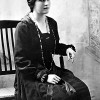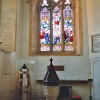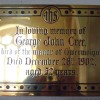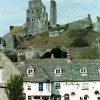On the 14th of October 1881 a fire broke out at Shapwick making nearly 80 homeless before it was brought under control. This small village is on the River Stour, overlooked by Badbury Rings. Just five miles south of Blandford Forum, itself no stranger to fires, it was virtually wiped out 150 years earlier and before that in 1564, 1677 and 1731 suffered the devastating consequences of fire. The residents of Shapwick didn’t have the Bastard brothers to rebuild their village.
The fire broke out between twelve and one o’clock and Mrs Andrews, who saw the thatched roof of a pigsty was on fire, raised the alarm. Her son immediately set off to get water to put out the fire. Reports say the wind was blowing a gale from the north-west at the time and the flames quickly spread to an adjacent barn and blazed on to the cowhouses and in an incredibly short time the whole area was burning out of control. A large rick of about 40 tons of meadow hay also caught fire.
Burning thatch was carried on the wind to buildings opposite which were quickly alight and from there jumped to a double cottage occupied by Mary Ann Hammett and her three children and Henry Kerley, his wife and two children. The wind continued to display its destructive power carrying the flames across the street and setting alight a cottage occupied by Mr. Cutler and Robert Cuff, his wife and five children. One pig was burnt alive and another was so badly burned it had to be killed, they were the property of Mr. Cutler and as far as is known were the only livestock lost to the fire. Other animals were let loose and escaped.
Even though the mostly semi-detached cottages were distanced from each other the menace of the gale negated any protection that might have afforded them and the fire travelled rapidly from home to home leaving little time for villagers to salvage their possessions.
A cottage occupied by Mr. Henry Masterman, foreman to Mr Martin Small, with two grandchildren and Charles Cuff and his wife were next in line to be attacked by the flames, which raced towards the home of Phares Kerley and his wife and child and then travelled on to set alight the homes of Henry Foster and Mary Oats.
The gale, still not satisfied with its destructive work, roared on carrying the flames to the homes of Peter Kerley and his mother. Then it was the turn of William Boyt and his wife and Robert Boyt and his sister.
James James had to get out quickly along with his two daughters, son and two grandchildren. The next house, occupied by Israel Andrews, his wife and four children adjoined the house of Mr. Feltham the shopkeeper and was partly used as a post-office: he lived there with his daughter. This property was of brick with a tiled roof and was better able to rebut the advancing flames. Most of the post office papers and stamps were saved and this building at least was left standing but it didn’t stop the fire, which continued its advance to the next cottage, the home of Martin Kerley, his wife and ten children. One of Mr Kerley’s daughters was recovering from rheumatic fever and was immediately carried to a place of safety. Thomas Kerley’s house, which he occupied with his wife and daughter and grand daughter, was the last house of the row to fall to the elements. Due to the heroic efforts of the villagers the fire stopped here and was prevented from advancing further up the street.
The elements persisted in attacking the next cottage but strenuous effort was made pouring water onto the roof and although the fire caught several times the cottage was saved. Not to be defeated the wind carried burning thatch over the garden to the smithy of Mr. W. Guy and his shop and house were soon consumed by the flames; the nearby home of Charles Weeks, his wife and six children was burnt out.
Soon after the alarm had been raised messengers were sent to Wimborne and Blandford and fire engines attended from both towns. It was mostly due to the efforts of the Wimborne fire brigade that the fire was stopped from spreading past Charles Week’s house. The Wimborne brigade saved Henry Frampton’s home, which was some comfort as he looked-on while a large barn he used to make hurdle, crib and spar in was set ablaze, the fire taking most of his materials and stock.
The Blandford engine and brigade arrived in the village shortly after and immediately set about putting out the hay rick at the other end of the village and saving the Anchor Inn and Mr Andrews house. The cottages being mainly built with mud walls and thatched roofs were easy prey for the fire and were quickly laid down.
Adding to the distress of the villagers was the loss of their winter stocks of potatoes and apples as well as their winter fuel, which most had stored in or nearby their cottages; very little was saved.
It was reported that with the exception of Mr Guy’s smithy and part of a property belonging to dairyman Mr Bartlett, the household effects of the tenants were uninsured. The cottages were owned by Lord of the Manor Mr Bankes of Kingston Lacey and were insured with the Atlas insurance office, of which Mr Bankes’ land steward, was the agent.
The Lord of the Manor with his daughter and land steward visited the village late on Friday and again on Saturday to see the extent of the damage. Mr Bankes sent £100 to the vicar the Hon. and Rev. A.G. Douglas to be distributed among the unfortunate cottagers to meet their immediate needs. Villagers whose cottages had escaped gave shelter to less fortunate neighbours and Mr Bartlett of New Barn, Mr Martin Small and other local farmers provided shelter for others. Mrs Douglas and her daughters looked after the younger children at the vicarage.
On Sunday special collections were made during church services at Blandford and Wimborne and collections were made at Sturminster, and Spetisbury and other towns and villages. The scene of the fire was visited by hundreds of people on Sunday when it was said the main street was almost impassable due to the throng of people.
The gale that propelled the fire caused widespread damage in the wider locality, bringing down trees and damaging farm buildings. On Lord Portman’s estate, shortly after six o’clock on Friday morning, an elm tree was brought crashing down through the roof of a hurdle-house.
The local newspapers described the fire as one of most terrible and disastrous fires that had ever occurred in the locality. 17 houses and cottages, three large barns, cowsheds and outhouses together with almost all their contents were lost. Someone visiting the area on the following Sunday said “ the village presented a sad, desolate appearance, only portions of walls and chimney stacks marking the spot where but a short time before many industrious labourers and their families resided.”



